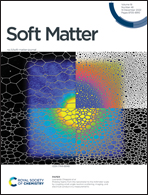Morphologies and dynamics of free surfaces of crystals composed of active particles†
Abstract
Active matter exhibits various collective motions and nonequilibrium phases, such as crystals; however, their surface properties have been poorly explored. Here, we use Brownian dynamics simulations to investigate the surface morphology and dynamics of two-dimensional active crystals during and after growth. For crystal growth on a substrate, the position and roughness of the crystal surface reach steady states at different times. In the steady state, the surface exhibits superdiffusive behaviour at the short time, and the roughness is insensitive to the roughening process and particle activity. We observe two-stage and three-stage surface roughening at different Péclet numbers. The result of dynamic scaling analysis shows that the surface is similar to anomalous roughening, which is distinct from the normal roughening typically found in conventional passive systems. Capillary wave theory for a thermal equilibrium system can describe the active surface fluctuations only in the long-wavelength regime, indicating that active particles mainly drive the surface out of equilibrium locally. These similarities and differences between the active and passive crystal surfaces are essential for understanding active crystals and interfaces.



 Please wait while we load your content...
Please wait while we load your content...